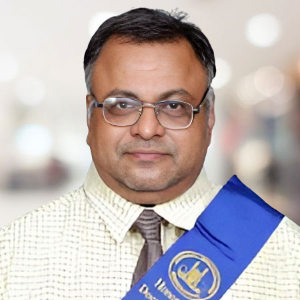Title : Environmental health impact assessment (EHIA) processing investigations during the post covid world for an efficient plant biology and biotechnology towards sustainable development
Abstract:
Many plant biology and biotechnological industries are increasing to fight the pandemic. Sustainable development is a kind of development that meets the needs of the present without compromising the ability and efficiency of future generations to meet their own needs. Environmental health impact assessment (EHIA) can be defined as the systematic identification and evaluation of the potential environment health impacts or effects of plant biology and biotechnology industrial projects, plans, programs, policies or legislative actions relative to the physical-chemical, biological, cultural and socioeconomic components of the total environment (1). EHIA is proposed for all the plant biology and biotechnology engineering plants for sustainable development (2).Total quality management (TQM) is based on quality and sustainability management from the customer’s point of view (3). TQM processes are divided into four sequential categories: plan, do, check, and act. This is also called the PDCA cycle for continuous process improvement. In the planning phase, bio- industrialists define the problem to be addressed, collect relevant data, and ascertain the problem’s root cause; in the doing phase, bios industrialists develop and implement a solution, and decide upon a measurement to gauge its effectiveness and efficiency; in the checking phase, bio industrialists confirm the result through before-and-after data comparison; in the acting phase, bio industrialists document their results, inform others about process changes, and make recommendations for the problem to be addressed in the next PDCA cycle. The industries must adopt the triple bottom line framework towards the concept of economic, environmental, and social entrepreneurship (4). Environmental impact assessment can be defined as the systematic identification and evaluation of the potential environmental impacts (effects) of the proposed plant biology and biotechnology industrial projects, plans, policies, programs, or legislative actions relative to the physical-chemical, biological, bio-chemical , biophysical, cultural, socio-economic, and anthropological components of the total environment(5). Strategic environmental assessment (sea) process can be broadly defined as a study and check of the potential impacts (effects) of a proposed project, program, plan, policy or legislative action on the environment and sustainability (6).The legislation of EIA process was established in 1970 by the enactment of the National Environment Policy Act (NEPA) in the USA. This was first time that EIA process became an official tool in scientific sector to protect the environment. Three of the significant terms while complying with the requirements of NEPA process are “environment inventory”, “environment impact assessment process”, and “environment impact statement”. EIAs of design research structures were undertaken in order to protect environment during the year 1950 in Japan, Europe and North America (7). The purpose of the EIA process is to encourage the consideration of the environment in organizational planning and decision making process. Historically, the choice of proposed projects, policies, plans, programs, permits, procedures or legislations was primarily based on only one criterion called economic viability. Today, it is necessary to consider three criteria of economic, environment and social viabilities.
The pre covid World has been characterized by the passage of legislation dealing with the environment including legislations of control of water, air and land pollution, solid and hazardous waste management, resource conservation and recovery protection (RCR), and soil and groundwater remediation. It is proposed that Industry 4.0 impacts (effects include source specific, industry-specific, and generic generation or decay ) protocol for SEA process for the performance of sustainable environmental plant biology and biotechnology industrial engineering plants is helpful for sustainable development. SEA process is a predictable process that is devised in to two phases (8). The first phase is called initial environment and sustainability evaluation (IESE) and the second phase is environment and sustainability impact studies (ESIS). IESE has been carried out for genetically modified Bt Cottons and genetically modified naturally pigmented colour seed-cotton (or kapas) varieties during the research year 1992-1993 at Central Institute for Research on Cotton Technology , Bombay to determine whether potentially adverse effects on environment and sustain efficacy with respect to physical, chemical, biological, economical, socio-economic environment and on human health and well-being are significant or whether mitigation measures can be adopted to reduce or eliminate adverse environment and sustainability impacts (9). Detailed SEA procedure can be called as ESIS that was applied to identify and evaluate the environment and sustainability consequences both beneficial and adverse impacts in order to ensure that the environment and sustainability impacts were taken in to consideration in organization’s planning and decision making process (10). SEA process is designed to identify and predict the potential impacts of the physical, biological, ecological, socio-economic, cultural environment and on human health and well-being are adequately protected (11) .


